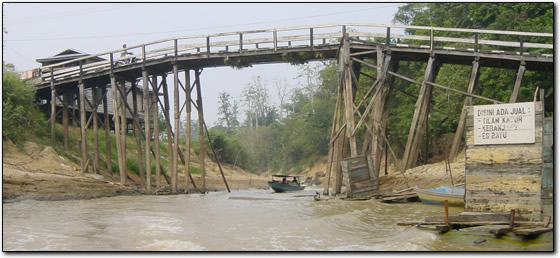
Tanjung Issuy
Upriver from Samarinda, a bustling logging town on the Mahakam River, are a series of wetlands known for their bird life and indigenous culture. Tanjung Issuy is a Dayak village on the shore of one of these large lakes. At Kota Bangun, the end of the road, we stopped to find an outboard skiff to take us across the lakes, a four-hour ride. All kinds of boats plied the wide Mahakam River at this point. Barges loaded with coal, ferries with cars and heavy equipment, flatbeds piled with logs, river boats with passengers, smaller longboats carrying freight and tiny skiffs transporting just a few people or goods cruised along the muddy waters. We quickly turned into a narrow channel, passed a few floating villages and were soon zooming across the wide open lake. The channel narrowed again. The water level was low. When we passed another floating village it was a tight squeeze between the fish farms, wooden platforms and floating outhouses.
 |
 |
Out on the lake again we saw groups of white egret and giant heron as well as large flocks of duck. Along the muddy flatlands near the channel we started to see dead birds. Suddenly we saw a small white egret, browsing along the shore, keel over and die. As we passed its legs were still twitching. Further ahead we encountered villagers laying out poison for the birds. They passed us in their open boat, collecting the dead birds, presumably to eat or sell. Who would buy poisoned meat? In the floating villages, purple herons and fuzzy-headed giant storks with large beaks were tied to the docks. We heard later that they were fattened up to be eaten. Along a forested channel we passed several proboscis monkeys foraging leaves. With a fat belly and a large red nose, the male looked like a jolly Santa Claus.
 |
 |
In Tanjung Issuy we stayed in a former longhouse that had been converted into a guesthouse. The traditional houses in the village were decorated with Dayak woodcarvings. We hired boats to take us on a tour of a nearby river, but because of the low water level we were forced to turn back before we could go very far upstream. A western biologist with strong ties to the area was staying in the longhouse. He talked about threats to the local environment: illegal palm oil plantations, non-Dayak settlers invading the wetlands and family feuds of forest burning stirred up by outside commercial interests.
